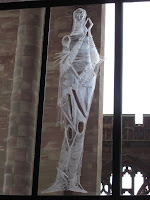I have been looking forward to this part of the painting module. I find the representation of people in art and graphic design fascinating and would like to develop my own response to the shapes and movement I see around me every day. I perceive this part as an opportunity to explore the impact of my marks, colour, shapes and texture on a complex and varied subject matter.

 During a recent visit to Coventry I was inspired by the art associated with the Cathedral buildings particularly the sculptures and and glass engravings based on human forms. The scale and positioning of these works of art added to the visual and emotional impact. The choice of material be it stone, metal or glass provided opportunities and limitations which the artists had exploited.
During a recent visit to Coventry I was inspired by the art associated with the Cathedral buildings particularly the sculptures and and glass engravings based on human forms. The scale and positioning of these works of art added to the visual and emotional impact. The choice of material be it stone, metal or glass provided opportunities and limitations which the artists had exploited.
When working in paint on a two dimensional surface an artist can exploit the two dimensions or through the use of tonal effects create the impression of a solid three dimensional person. At the Herbert Art Gallery & Museum adjacent to Coventry Cathedral, I came across two portraits by the artist John Howard Jepheott (1910-1984) which interested me. Both "The picture of a girl - the innocent" (illustrated here) and "Portrait of an intellectual", painted in 1959, are angular portraits where colour variation contained within bold lines create interest within a predominantly two dimensional image.
 My own initial sketches for this part of the course were prepared at a local art group evening with a professional life model. Short pose pencil sketches were followed by slightly longer poses that provided the opportunity to experiment with colour. The professional model was able to vary and hold poses with relative ease. However, the provision of the model at the evening event was a change to the published programme so I only had my A4 sketch book available to practice in.
My own initial sketches for this part of the course were prepared at a local art group evening with a professional life model. Short pose pencil sketches were followed by slightly longer poses that provided the opportunity to experiment with colour. The professional model was able to vary and hold poses with relative ease. However, the provision of the model at the evening event was a change to the published programme so I only had my A4 sketch book available to practice in.
Whilst progressing the course exercises, I have referred to John Raynes books "Complete Anatomy and Figure Drawing", Batsford 2007 and "The Figure Drawing Workbook", Collins & Brown 1997 as well as continuing my visits to galleries and searching examples of artists work on the Internet. My wife has been the principle subject for the exercises for which I am most grateful.
 Pencil and charcoal sketches enabled me to observe structure, proportions, tone and weight. I find that using water soluble pencil provides the flexibility to move from line to tonal washes easily which suits life drawing. The need to fix charcoal, I find more limiting than pencil or pen work although the ability to achieve greater density of line and a range of soft tones means this medium can not be ignored. I used images of Euan Uglow's (1932-200) work as inspiration for poses suitable for my life model (i.e my wife) to hold comfortably.
Pencil and charcoal sketches enabled me to observe structure, proportions, tone and weight. I find that using water soluble pencil provides the flexibility to move from line to tonal washes easily which suits life drawing. The need to fix charcoal, I find more limiting than pencil or pen work although the ability to achieve greater density of line and a range of soft tones means this medium can not be ignored. I used images of Euan Uglow's (1932-200) work as inspiration for poses suitable for my life model (i.e my wife) to hold comfortably. Having produced a number of quick sketches, I moved into experimenting with colour. I tried to contrast the warmer skin tones with cooler colours for areas in shadow. Each of the images below were produced in single, relatively short sittings using acrylic paint.
The study of the reclining nude enabled me to experiment with colour and brush marks. The work was completed in a single sitting and as such feels unfinished and flat. I have yet to decide whether to re-work over this initial piece as I am happy with the overall structure. The composition of the sitting pose does not feel as balance as I would like with the left foot sticking out. I have been freer and more expansive with my marks working in places with a painting knife. There appears to be more energy in this piece which again was produced in a single sitting fairly quickly.
At this stage I looked for more inspiration from the work of other artists and selected a few whose approach I found interesting.
I have decided to pause on this exercise whist I reflect on the study of other works and move onto the next exercise in the module before revisiting my study of the human form in paint.








No comments:
Post a Comment